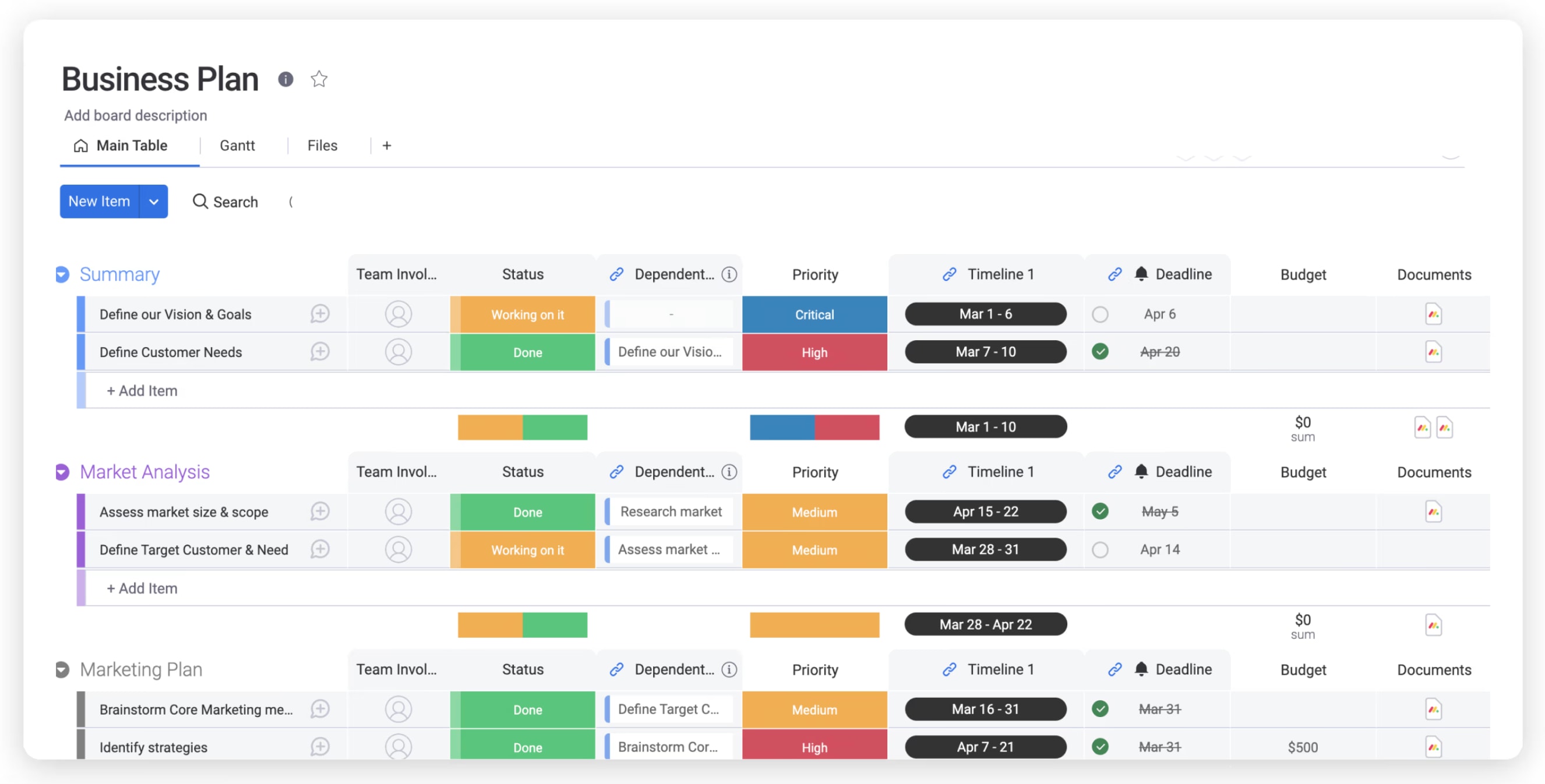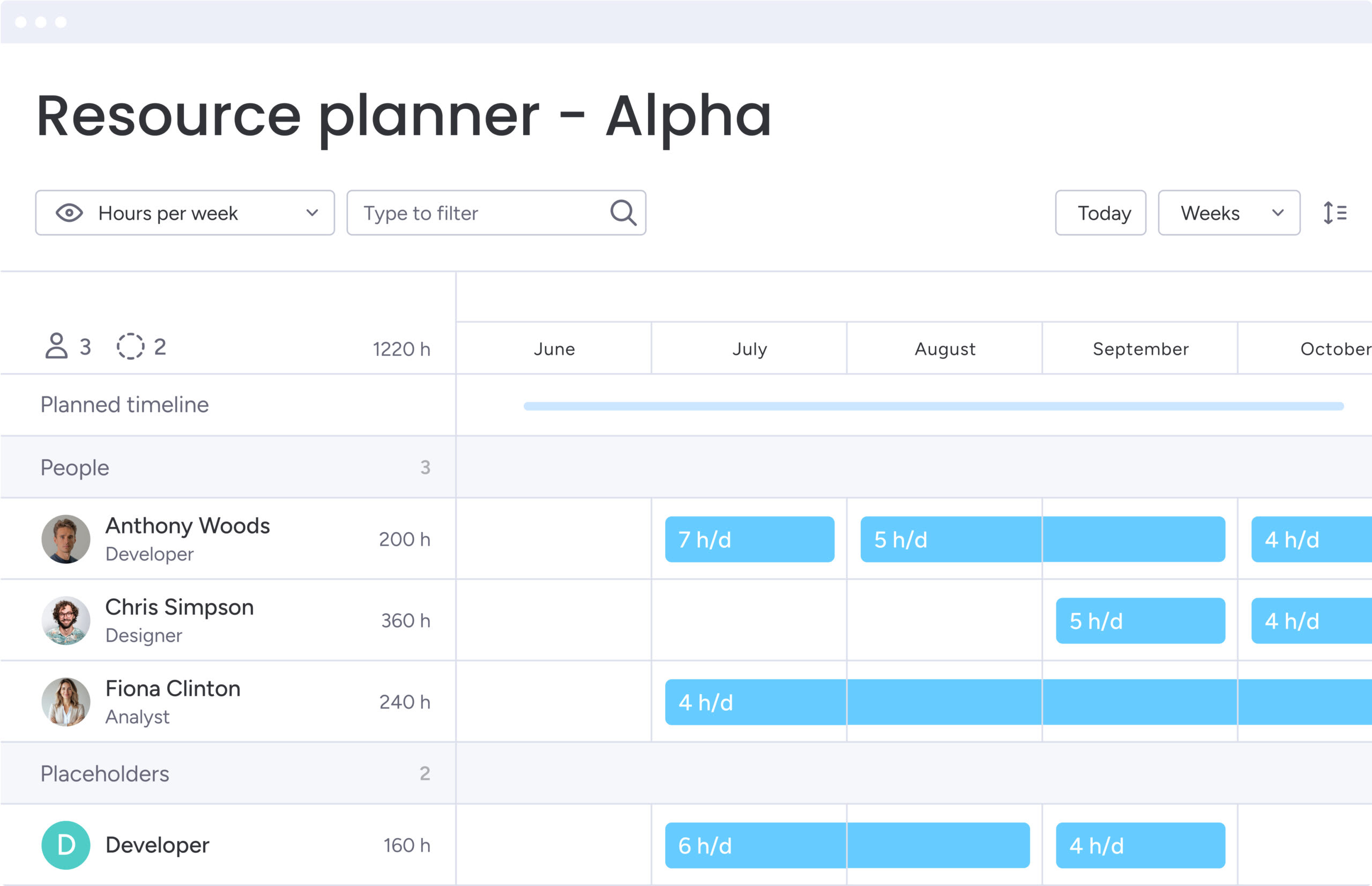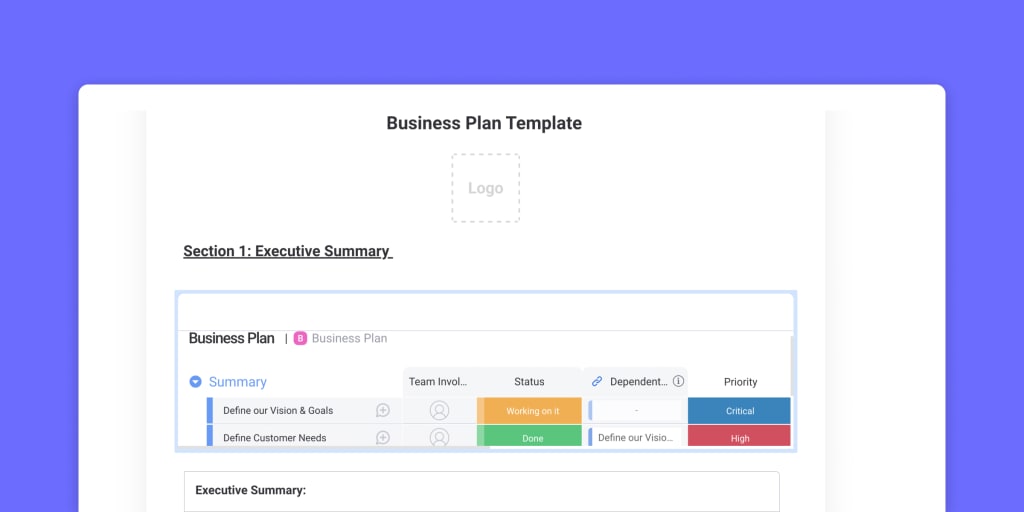Launching a new business is harder than ever. With more startups competing for the same pool of investors, standing out requires a clear, strategic approach.
Investing time before launch to outline your business’s goals, funding needs, and projected profits in a solid business plan can set you apart. But building a strong plan means more than just pulling a few paragraphs together, and that’s where templates come in.
In this article, we’ll break down what a business plan template includes, the different types you can use, tips to maximize your plan’s impact, and how monday work management can give your startup the edge it needs to win over investors.
Get startedWhat is a business plan template?

A business plan is a written document outlining a structured framework for how a company intends to achieve its goals. These objectives can be anything, such as obtaining a particular market share, growing revenue, or reaching the next round of funding.
While companies of all stages and sizes use business plans, they are especially beneficial for startups and new businesses as they can help secure new investments.
A business plan template is a customizable document that breaks down every section of a business plan to make it easier to organize ideas and create a coherent document. A template also details how companies will meet these goals after launching the business plan.
What’s included in a business plan template?
A business plan template can include a wide range of different topics, projections, goals, and descriptions. While there’s no set length for these plans, they typically range between 15-30 pages, and can even extend to 50 pages for presenting a more complex business opportunity.
Business plan templates usually follow a structure outlining goals, teams, and financials, and prompt businesses to answer essential questions that may come up for stakeholders and potential funders. Here is what is typically included in a business plan:
- Executive summary: What are your company’s goals and vision?
- Company description: What does the business do and what problems does it solve? Include overview and mission too.
- Organization and management: Who are you? What key hires have been made, and what expertise do they bring to the table? What makes your team right for this venture?
- Market and industry/competitive analysis: Who are your target customers? What are their interests, pain points, and goals? Who are your competitors and what are your company’s competitive advantages?
- Marketing & sales strategy: What are your key marketing strategies? How do you plan t to attract new customers? What are your sales strategies?
- Key products/services: What will you be offering? What makes it unique?
- Financial plan and funding request: What do current revenue streams, cash on hand, revenue structure, required funding, and investments already received look like?
Startups also often include projected timelines in their business plan, which includes milestones for business development and launch. Using a platform like monday work management ensures that all these sections are easy to organize, update, and collaborate on, without digging through scattered docs.
Additionally, you want to keep your plan organized with a table of contents at the beginning and appendices at the end, featuring legal documents, permits, patents, cash flow statements, and licenses.
How startups benefit from using a business plan template
Getting funding for a new venture isn’t easy. Statistics show that in recent years, fewer seed-stage startups are getting series A funding. New businesses seeking buy-in from venture capitalists may struggle more than in previous years to get off the ground, which is why managing cash runway is essential.
To secure investments, you need to show potential investors that your business is in order. A business plan template helps showcase your strategies and ideas in a precise and concise manner. That said, business plan templates aren’t just useful for funding; they have several other benefits, such as:
- Attracting talent: Potential employees take a risk by coming aboard a new company, and a business plan shows them there’s a clear direction.
- Alignment: For companies launching with one or more business partners, the business plan becomes the single source of truth for all parties.
- Clarity on future goals: Clarity isn’t just for investors and talent; it’s also helpful and important for employees to understand where the new business will go.
- Provides structure: Instead of starting from a blank page and drafting whatever comes to mind first, the template serves as a guide through every section.
- Maintaining consistency: A template provides consistency so stakeholders spend less time trying to navigate the structure and more time discussing and implementing the plan.
While there is some benefit to spending significant time developing a comprehensive business plan, agility is often more important in the startup business world. Business plan templates make it easier for budding businesses to speed up the process of writing a plan. Rather than starting from scratch, a simple business plan template provides the structure teams need to make sure all the most important information is included from the get-go.
Get the template4 types of business plan templates (with examples)
There are dozens of business plan templates, each with its own structure and flow. Having an idea of what you need to get across and include in your template will help you stay on track and limit delays. There are different types of business plans, meaning there are different templates, too. Choosing the right one is key to getting started on the right foot.
Below, you can see a side-by-side comparison of the different types of business plans to make it easier for you to choose the right template. For more details on each one, keep reading.
| Type of business plan | Audience | Purpose | Average length |
|---|---|---|---|
| One-page business plan | Investors, pitch judges, vendors, partners | Provide a concise, high-level summary of the business | 1 page |
| Startup business plan | Investors, financial institutions | Secure funding by outlining business concept, team, market, and finances | 15–30 pages |
| Operational business plan | Internal teams, managers | Guide daily operations, workflows, and resource allocation | 30–100 pages |
| Growth business plan | Stakeholders, investors, internal teams | Set strategic goals and define expansion plans and future direction | 15–25 pages |
1. One-page business plan template
A one-page business plan template, sometimes also referred to as a lean business plan, is perfect for creating a plan to bring to the next startup pitch. But of course, supplementing the template with appendices for financial reports like balance sheets or income statements is important.
Summarizing the entire business into a single page is a great exercise, but it’s important to know when to use a one-page template and a more extended one. A one-pager ensures a robust and concise knowledge of each area of operation, creating more confidence to discuss each point with potential investors.
2. Startup business plan template
A startup business plan is a detailed document outlining your plans for a new venture. Most of the time, the goal of a startup business plan is to secure new funding. In the plan itself, it’s important to summarize the intended business concept and functions, introduce the executive team, and demonstrate a deep understanding of market trends and your target audience.
Financial forecasts are another critical part of startup business plans, as they can help potential investors understand what kind of funding you need and your expectations for profits over time. When searching for a startup business plan template, make sure it includes a wealth of pages and sections that you can customize for your business.
3. Operational business plan template
Even if you’ve already made a startup business plan or another type, it’s a good idea to also create an operational business plan. The goal of this type of plan is to outline how your business will operate down to the small details, making it an essential internal document for your management team.
Operational business plans help teams map out how the business works on a daily basis, including details like:
- Specific workflows
- Hiring strategies
- Company best practices
- Resource allocation
- Assigning responsibilities
- Budgeting by team
4. Growth business plan template
A growth business plan is what it sounds like: a plan to detail how you plan to scale and expand your business. This business plan should be a little more strategic than the others, as it involves looking towards the future and determining goals and how you’ll work to achieve them.
A growth-based plan is important for stakeholders to understand how your business intends to grow, but it’s also used internally to guide all team members towards the same objectives. This plan may include additional elements like marketing tactics, a SWOT analysis, product expansion plans, and more.
Pro tip: Each of these formats can be created using monday work management’s customizable templates, so you can get started fast and adapt the structure to your specific needs.
Or start with a pre-built prompt:
Tips for getting the most out of a business plan template
Here are a few tips to make the most of your business plan and the template you use so you can make sure your plan works.
1. Use simple, approachable language
The goal is for people to read the business plan, so make sure you use everyday language over complex jargon and corporate terminology. Anyone who comes across the plan, from investors to potential partners or candidates, will have no issue understanding it.
2. Write the executive summary last
The executive summary is a short section that summarizes every aspect of the business plan. So, first, write the entire plan and then move on to summarizing it.
3. Add supporting documents
While simple business plans are effective in offering a snapshot of your business, they leave out a lot of information by nature. Consider supplementing the plan with appendices such as financial statements, data sets, and market analyses for a more well-rounded company overview.
4. Be conservative with financial estimates
As much as possible, financial projections should be based on real-life data. But even with the most accurate and up-to-date information, there’s always room for interpretation. So it’s best to give a range where possible, and if not, stay conservative with financial estimates.
5. Include thorough research and analysis
Invest the time early on and capture accurate, comprehensive data to support all claims. Interview customers and prospects to get a realistic overview of your target customers. You can choose to hire a professional firm to provide a market research report, or do it yourself by selecting an intelligent platform like monday work management, which uses AI and automations to generate real-time reports and business insights.
Get startedWhy to create a simple business plan template with monday work management
Most free business plan templates come in PDF, Google Docs, or Microsoft Word formats. While these are popular formats and tools, they don’t tend to be particularly collaborative. When you use a platform like monday work management, you can access different business plan templates that are entirely customizable.
Whether you’re working on a one-page plan or a longer operational one, you can create different boards to manage multiple business plans in one unified solution. With tons of custom fields and ready-to-go templates, your team can easily build a very simple plan or a highly complex one that includes various attachments, links, and additional documents.
Here’s a closer look at the features that make monday work management a great option to host your business plan.
Create action items directly from your plan

Once your business plan is built and finalized, you can create action items for projects directly from your template. Set up a collaborative board to manage your marketing plan, create tasks and assign them along with due dates to team members, plan resources, and turn that business plan into reality.
Collaborative and shareable experience

What’s great about using a platform like monday work management is that even if your team is spread out, everyone can still work together on the same business plan while staying in the loop on all communications. When you’re ready to share your plan, you can easily invite stakeholders to take a look at your work.
Monitor progress with advanced reports and dashboards

Keep track of specific KPIs and overall team performance once you do get started on projects so that you can see whether you’re aligned with your goals and operational objectives. Get real-time reports and updated dashboards to visualize progress and highlight areas that need closer attention.
Getting the funding you need starts with the right template
Your business plan is your key to securing the funding your startup needs. More than that, it serves as a roadmap to guide your team toward business and financial success while giving stakeholders a much-needed vision of what to expect from your business. Choosing the right template is critical here, as it will put you on the right path, which is why a flexible, customizable, and detailed business plan template from monday work management is a great choice.
Get startedFAQs
How can I write a simple business plan?
To write a simple business plan, focus on clearly outlining your business idea, target market, value proposition, revenue model, and basic financials. You can do this first in a one-page format and then slowly expand it out to get a more detailed business plan.
What are the 7 parts of a business plan?
The seven components of a business plan include: Executive summary, company description, organization and management, market and industry analysis, marketing and sales strategy, key products or services, financial plan and funding request.
What are some common mistakes in a business plan?
There are a lot of ways your business plan can go wrong, whether it’s from a lack of research, unrealistic financial estimates, not including relevant analyses, or providing too much or not enough information. To avoid common mistakes, make sure to use a business plan template such as the one from monday work management to make sure all the necessary components are there.
Can I write a business plan myself?
Yes, it’s possible to write a business plan yourself entirely from scratch, however, templates from platforms like monday work management make it easier. When working on a business template that you build on your own, it’s easy to forget small details that can have a big impact on the final plan; templates make sure all the information you need is covered.
How long should a startup business plan be?
A startup business plan can vary in length but generally sits at around 15-30 pages long. Of course, for more complex business ventures, this can grow to 50 or even more pages, but what’s most important is that you cover all the necessary components and that your company’s value is communicated clearly and concisely.
 Get started
Get started 

